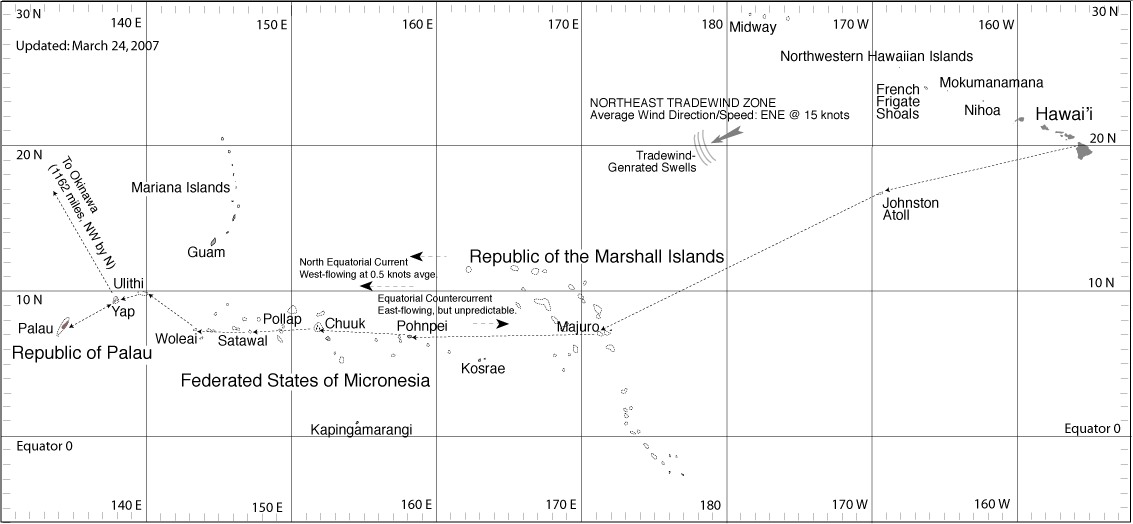Kū Holo Mau: 2007 Voyage for Mau (January 23-April 12)
Introduction
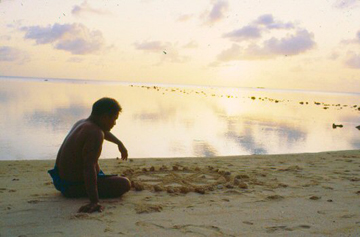
Navigator Pius Mau Piailug on the beach at Satawal, with a star compass in the sand (1983). Steve Thomas Traditional Micronesian Navigation Collection, online at the University of Hawaii at Manoa Library.
A Voyage for Mau
Pius Mau Piailug, a master navigator from the island of Satawal in the state of Yap, Micronesia, was Hōkūle’a’s first navigator. In 1976, he guided Hōkūle’a on a 2,300 mile voyage from Hawai‘i to Tahiti, the first voyage in over 600 years navigated without instruments on this ancestral Polynesian sea route.

Mau on Satawal (2007). Photo by Sam Low
The success of Mau’s navigation sparked pride in the Hawaiian and Polynesian culture and a renaissance of voyaging, canoe building, and non-instrument navigation that has continued to grow, spreading across Polynesia and reaching to its far corners of Aotearoa and Rapanui and creating a family of Pacific voyagers.
The 2007 voyage to Mau’s home island of Satawal was a journey to honor and thank Mau for his teaching. The name of the voyage, “Kū Holo Mau / Sail On, Sail Always, Sail Forever,” given by Pua Kanaka‘ole, emphasizes the perpetuation of Mau’s voyaging and navigation tradition.
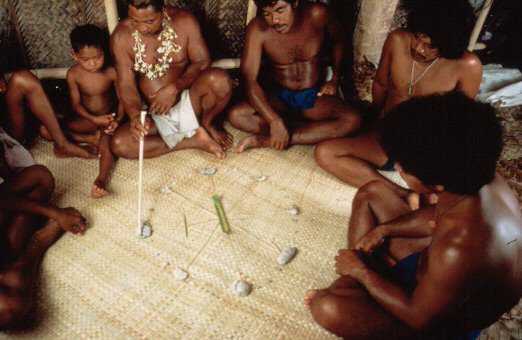
Mau teaching navigation on Satawal. Steve Thomas Traditional Micronesian Navigation Collection, online at the University of Hawaii at Manoa Library.
Maisu: A Gift for Mau
After five years of work, Na Kalai Wa‘a Moku O Hawai‘i launched the deep-sea voyaging canoe Alingano Maisu in Kawaihae Harbor on Saturday, October 21st, 2006. With twin hulls are 54-foot long and an overall length of about 56 feet, Maisu was built as a gift for Mau, to honor his achievement and thank him for his teaching and to help him keep his navigation tradition alive in Satawal. This gift completes a circle of giving.
“The direction was provided by navigator Clay Bertelmann and his brother Shorty, two students of Mau. "... the majority of the work was done by the family of the voyaging canoe Makali‘i, an association called Na Kalai Wa'a Moku o Hawai‘i," headquartered in Kawaihae, on the Big Island of Hawai‘i.
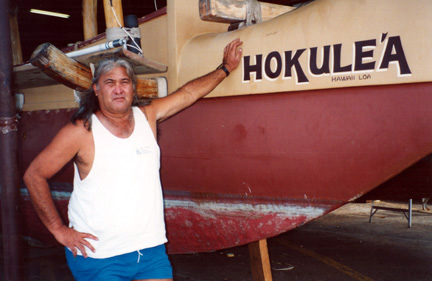
Navigator Clay Bertelmann
"But there are parts of the canoe that represent a statewide gesture. Na Kalai Wa'a stalwart Pomai Bertelmann said the hulls came from the canoe Hokualaka‘i [a Hilo voyaging canoe] and were built by Jay Dowsett; the steering sweep was contributed by the Friends of Hōkūle’a and Hawai‘iloa; the canoe Iosepa’s clan gave the boom, engine and equipment; Kaua‘i’s Namahoe canoe project contributed kauila wood for the mast step; and vast amounts of labor were volunteered by Maui’s Mo‘okiha canoe project as well as folks from across the state as well as from the Mainland, Tahiti and New Zealand” (From the blog of Jan Tenbruggencate , Jan. 14, 2007).
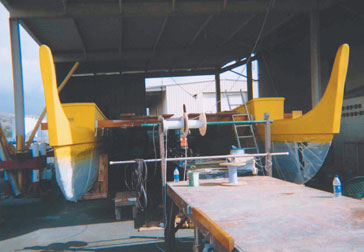
Maisu Hull, at Kawaihae. Photo by Wes Correa
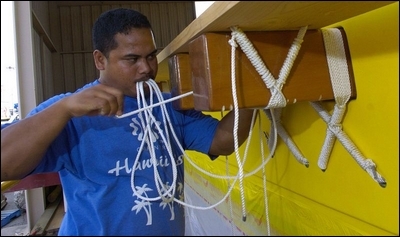
Lashing Maidu. Photo by Honolulu Advertiser
Alingano Maisu [pronounced mai-shu] is the name of a wind that causes the ‘ulu (breadfruit) to fall from the trees. The people of Satawal cannot pick the ‘ulu, their main food item, until the chief of their island says they can, unlesss the wind blows the ‘ulu from the tree, in which case people are free to gather and eat it without permission. “When it stay breadfruit season in our island, and a strong wind coming and shake all the breadfruits down, then you can go and collect it, even if it is not your tree,” Mau says. “We call that ‘maisu.’”

Maisu at Sea
In the same way, he says, the canoe Maisu will be available for anyone to partake freely of its learning: “Today, Micronesia is becoming like Hawai‘i – a lot of modern custom. So I am trying to have a canoe to teach the kids navigation. They can come any time; the canoe is gonna be there waiting.” The canoe is like this wind, allowing the people to learn of their culture “free” from restraints. It will be for all.
Crew member Junior Coleman explains, “It’s Papa Mau’s last request to have this canoe for his islands, to help teach the youth about their cultural identity amid all these outside influences…. It would be a real symbol to look to, just as we look up to Hōkūle’a as a spark to give us cultural pride and motivation to do what’s right for our islands and our people.”
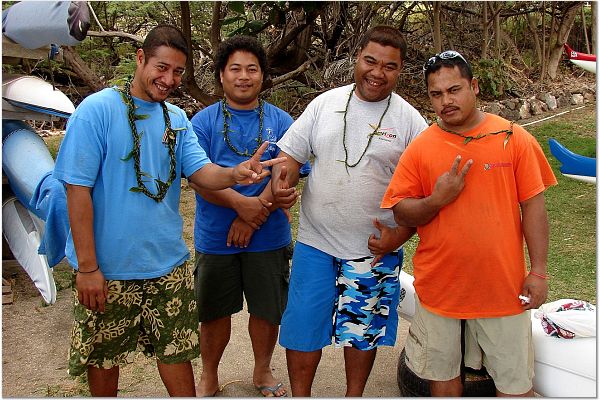
"Micronauts"
Students from the Kanu o Ka‘aina New Century Public Charter School, who also helped construct the canoe, chanted as Maisu was lifted up and into the water for the first time. Clay’s wife Dee Dee Bertelmann remarked “today, this is a canoe. Papa will be proud.” Clay’s daughter Pomai Bertelmann of Na Kalai Wa‘a Moku O Hawai`i pointed out “we had people from New Zealand, Argentina, South Africa, Japan, Hawai‘i, California, we had people from all over the world working on this canoe. We couldn’t have asked for more.”
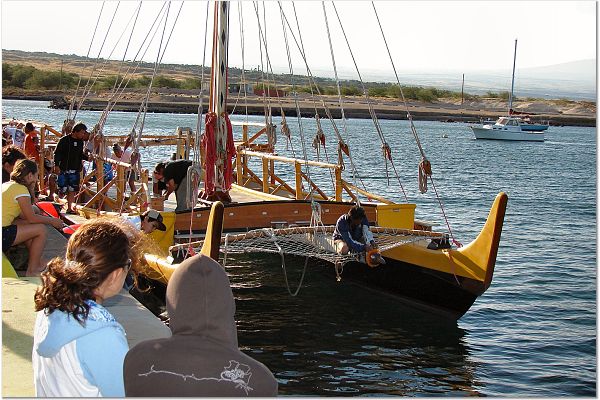
Maisu in Kawaihae Harbor before the Blessing Ceremony, 2007. Photo by Momi Wheeler
Mau could not be at the launching as he is at home in Satawal, but his cousin Thomas Raffipiy said in a gathering on the canoe that “his (Mau’s) vision has built a bridge between Hawai`i and Micronesia and it will be a bridge that I know a lot of the children and our children’s children will travel. Today when I was watching the canoe get off the trailer and into the water, I saw that vision.”
Yet gift-giving is not completed until the gift is delivered, and there was a sense of urgency to deliver it before the on-set of the next year’s typhoon season in Micronesia, as Mau was now 74 years old and increasingly suffering the effects of diabetes.
Master Navigator, Master Teacher: Reflections on Mau Piailug, by Nainoa Thompson (1996)
Hōkūle’a accompanied Alingano Maisu on this voyage, and the two canoes arrived at Satawal on March 14, 2007.
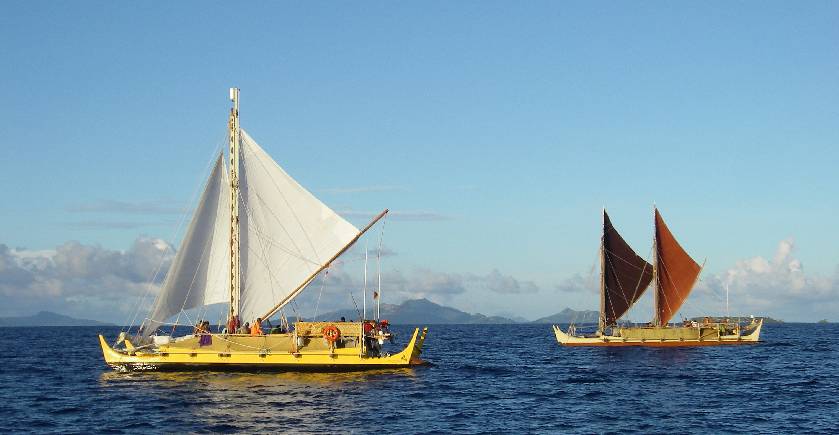
Maisu sailing to Chuuk (2007), with Hōkūle’a. Photo by Mike Taylor
An unexpected gift of this visit to Satawal was Mau’s initiation of five Hawaiians along with eleven Micronesians into pwo, an acknowledgement of their knowledge, achievements, and ability to serve their people as navigators.
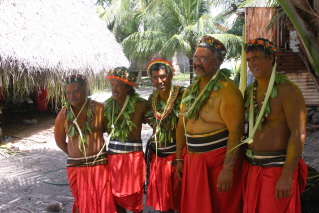
Five Hawaiian Navigators on Satawal (2007). Photo by Na'alehu Anthony
The five Hawaiians – Chad Baybayan, Shorty Bertelmann, Nainoa Thompson, Chadd Paishon, and Bruce Blankenfeld (left to right above) – served as captains and navigators of Maisu and Hōkūle’a during the 2007 Voyages to Micronesia and Japan.
Nainoa Thompson reflects on his teacher Mau:
We realized we did not know enough [to navigate Hōkūle’a as Mau had done in 1976]. We needed a teacher. Mau became essential. Mau is one of the few traditional master navigators of the Pacific left. And Mau was the only one who was willing and able to reach beyond his culture to ours.
I searched for Mau Piailug. Finally, I found him and flew to meet him. Mau is a man of few words, and all he said in answer to my plea for help was, "We will see. I will let you know." For several months I heard nothing. Then one day I got a phone call; Mau was going to be in Honolulu with his son the next day. When Mau arrived here back in 1979, he said, "I will train you to find Tahiti because I don’t want you to die." He had heard somehow that Eddie had been lost at sea.
I asked him to teach me in the traditional ways. But Mau knew better. He said, "You take paper and pencil! You write down! I teach you little bit at a time. I tell you once, and you don’t forget." He recognized that I could not learn the way he had learned.
Mau Piailug is from the island of Satawal. It’s a mile and a half long and a mile wide. Population 600. Navigation’s not about cultural revival, it’s about survival. Not enough food can be produced on a small island like that. Their navigators have to go out to sea to catch fish so they can eat.
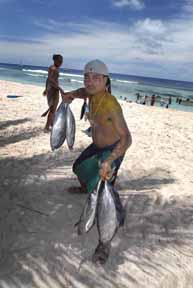


Photos by Sam Low
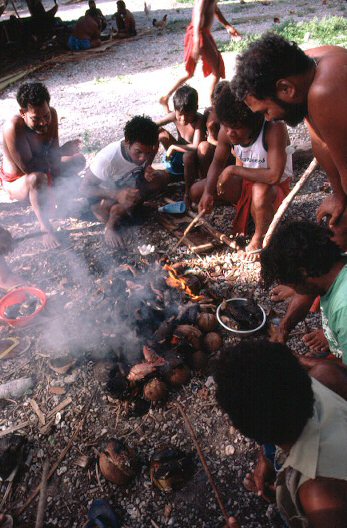
Cooking fish and coconuts. Steve Thomas Traditional Micronesian Navigation Collection, online at the University of Hawaii at Manoa Library.
Mau was not like me, who learned by using both science and tradition. I started at an old age, at about 21. He started at one. He was picked by his grandfather, the master navigator for his people, taken to the tide pools at different parts of the island to sit in the water and sense the subtle changes in the water’s movements. To feel the wind. To connect himself to that ocean world at a young age. His grandfather took him out to sail with him at age four. Mau told me that he would get seasick and when he was seven years old, his grandfather would tie his hands and drag him behind the canoe to get rid of that. This was not abuse. This was to get him ready for the task of serving his community as a navigator.
Mau learned to turn the clues from the heavens and the ocean into knowledge by growing up at the side of his grandfather-he had been an apprentice in the traditional way. He had learned to remember many things through chants and would still chant to himself to "revisit information."
Mau’s greatness as a teacher was to recognize that I had to learn differently. I was an adult; I needed to experiment, and Mau let me. He never impeded my experimenting and sometimes even joined in.
I never knew when a lesson started. Mau would suddenly sit down on the ground and teach me something about the stars. He’d draw a circle in the sand for the heavens; stones or shells would be the stars; coconut fronds were shaped into the form of a canoe; and single fronds represented the swells. He used string to trace the paths of the stars across the heaven or to connect important points.
The best was going out on my fishing boat with Mau ... every day! I watched what he watched, listened to what he listened to, felt what he felt. The hardest for me was to learn to read the ocean swells the way he can. Mau is able to tell so much from the swells-the direction we are traveling, the approach of an island. But this knowledge is hard to transmit. We don’t sense things in exactly the same way as the next person does. To help me become sensitive to the movements of the ocean, Mau would steer different courses into the waves, and I would try to get the feel and remember the feel.
Mau can unlock the signs of the ocean world and can feel his way through the ocean. Mau is so powerful. The first time Mau was in Hawai‘i, I was in awe of him-I would just watch him and didn’t dare to ask him questions. One night, when we were in Snug Harbor, someone asked him where the Southern Cross was. Mau, without turning around or moving his head, pointed in the direction of a brightly lit street lamp. I was curious and checked it. I ran around the street light and there, just where Mau had pointed, was the Southern Cross. It’s like magic; Mau knows where something is without seeing it.
I spent two Hawaiian winters with Mau. In the summer, ninety-five percent of the wind is trades, so it’s easy to predict the weather. Tomorrow is going to be like today. But in wintertime you have many wind shifts. When I had spent enough time with him, I realized that he was not looking at a still picture of the sky. If you took a snapshot of the clouds and asked him, "Mau, tell me what the weather is going to be," he could not give you an answer. But if you gave him a sequence of pictures on different days, he would tell you.
He said, "If you want to find the first sign of a weather change, look high." He pointed to the high-level cirrus clouds. "If you see the clouds moving in the same direction as the surface winds, then nothing will change. But if you see the clouds moving in a different direction, then the surface winds might change to the direction the clouds are moving. That’s only the first indication, but you don’t really know yet. If clouds form lower down and are going in the same direction as the clouds up high, there is more of a chance that the winds will change in that direction. When the clouds get even lower then you know the wind direction will change."
Satellite technology was in its infancy then, and many times Mau’s predictions would be right and the National Weather Service would be wrong.
He used the same clouds that we use to predict the weather--mare’s tails, mackerel clouds. But in his world, he practices a kind of science that is a blend of observation and instinct. Mau observes the natural world all day. That’s how he relates to nature. There are no distractions, so his instincts are strong.
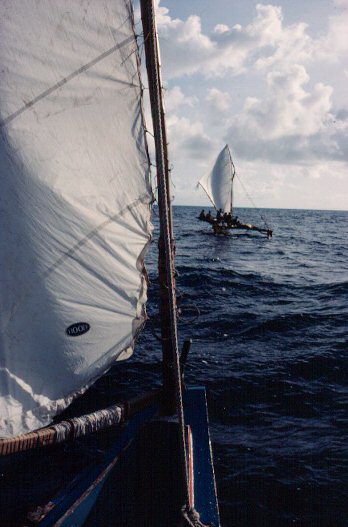
Two canoes from Satawal. Steve Thomas Traditional Micronesian Navigation Collection, online at the University of Hawaii at Manoa Library.
In November of 1979, Mau and I went to observe the sky at Lāna‘i Lookout. We would leave for Tahiti soon. I was concerned-more like a little bit afraid. It was an awesome challenge.
Then he asked, "Can you point to the direction of Tahiti?" I pointed. Then he asked, "Can you see the island?"
I was puzzled by the question. Of course I could not actually see the island; it was over 2,200 miles away. But the question was a serious one. I had to consider it carefully. Finally, I said, "I cannot see the island but I can see an image of the island in my mind."
Mau said, "Good. Don’t ever lose that image or you will be lost." Then he turned to me and said, "Let’s get in the car, let’s go home."
That was the last lesson. Mau was telling me that I had to trust myself and that if I had a vision of where I wanted to go and held onto it, I would get there.
On Mau’s Legacy
Year after year Mau came and took us by the hand as we prepared for our voyages. He cares about people, about tradition; he has a vision. His impact will be carried beyond himself. His teaching has become his legacy, and he will not soon be forgotten.
On the 1980 voyage to Tahiti Mau Piailug made a fundamental step. He became, instead of the navigator, our teacher. This was an incredible feat, considering he could barely speak English. He was the one who came to Hawai‘i and made this enormous cultural jump. I believe that the great genius of Mau Piailug is not just in being a navigator, but that he could cross great cultural boundaries and help us find our way at sea. All of this came from a very powerful sense of caring on his part.
At the end of the 1980 voyage, Mau told me, "Everything is there in the ocean for you to learn, but it will take you 20 years to see." Mau is right. For me to learn all the faces of the ocean, to sense the subtle cues, the slight differences in ocean swells, in the colors of the ocean, the shapes of the clouds and the winds, and to unlock these clues and glean information from them in the way Mau can, will take many more years.
Mau also told me,"Because of your age, you’ll never see it all. If you want Hawai‘i to have a navigator that knows all and sees all, send your children."
Mau is one of the last. He’s 64 years old now. He was initiated in the ceremony called po, which is for the graduation of deep sea navigators. Not mastery. And let’s keep in mind, I’ll make it real clear right now. I’m not a master navigator, not by a long shot. I’m just a student. Mau graduated because he could sail long. But mastery is only something that is bestowed upon a deep sea navigator at the death of his teacher. Mau became a master navigator when his grandfather died. Mastery is not accomplishment, it’s responsibility. He had the responsibility to carry on the survival of his people--an unbroken tradition three thousand years old.
Mau worries about the future of his way of life. He is one of five master navigators left in Micronesia.
He’s 64 years old [born in 1932], and he’s the youngest. Outside influences are changing the way young people in Micronesia look at life; it is a very confusing, turmoiled time. Young people are not learning the old ways. One of the things that he told me years ago is that a master navigator’s life is not fulfilled until there is someone to carry on his legacy after his death. That’s Mau’s concern: he has not trained someone among his people in navigation. Every time Mau came unselfishly to Hawai‘i to teach us about the old ways, we’d sit down and talk about that concern. Then in 1994, he came and told me. "It’s too late. I am too old, our children have too much to learn, and it’s too late." That’s something I never wanted to hear. But he said, "It’s okay. All navigators find a way out. When they put me in the ground, it’s all right because I already planted a seed in Hawai‘i. When my people want to learn, they can come to Hawai‘i and learn about me." Mau does not see navigation as cultural revival; it’s his way of life. His people will never come to learn from him until they want to live that way again.

A Traditional Canoe Sailing Off Satawal. From http://www.temjin.co.jp/2003w.htm.
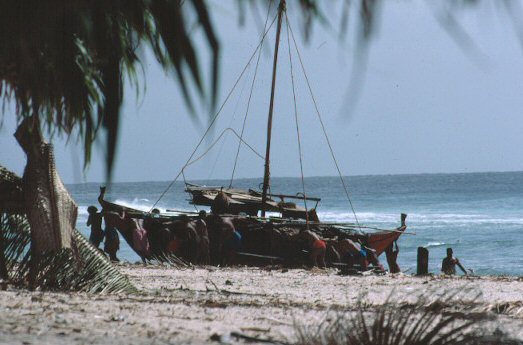
Hauling a canoe ashore on Satawal. Steve Thomas Traditional Micronesian Navigation Collection, online at the University of Hawaii at Manoa Library.
Time Line of Ku Holo Mau, 2007 Voyage to Satawal
On January 11, 2007 Hōkūle‘a and its escort boat Kama Hele departed from Honolulu for Kawaihae on the Big Island to join Alingano Maisu. After leaving Kawaihae on Jan. 19 and returning to Kealakekua Bay for repairs, the two canoes departed for Majuro, Republic of the Marshall Islands, on Jan. 23. All destinations were West of the International Dateline (180 degrees longitude) and one day ahead of Hawai‘i.
- Departed Kealakekua Bay, Hawai‘i on January 23; Arrived at Majuro on February 19
- Departed Majuro on February 22; Arrived at Pohnpei, Federated States of Micronesia, onMarch 1
- Departed Pohnpei on March 7; Arrived at Chuuk on March 10
- Departed Chuuk on March 12; Arrived at Satawal on March 15
- Departed Satawal on March 20; Arrived at Woleai on March 22
- Departed Woleai on March 22 p.m.; Arrived at Ulithi on March 24
- Departed Ulithi on March 25; Arrived at Yap on March 26
- Departed Yap on March 30; Arrived at Palau on April 1
- Departed Palau on April 6; Returned to Yap on on April 8
- Departed for Okinawa, Japan on April 12
